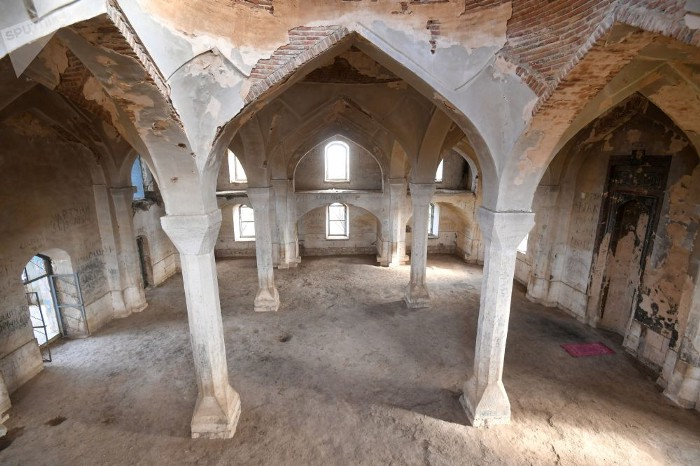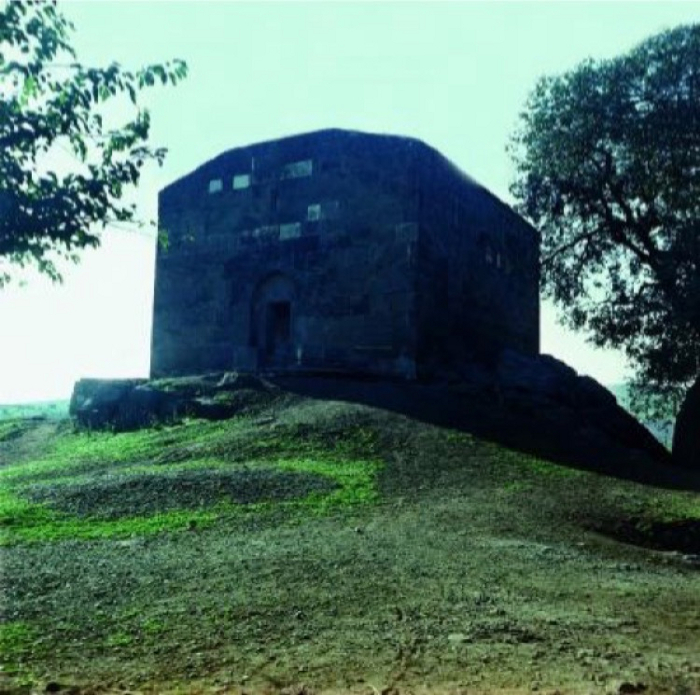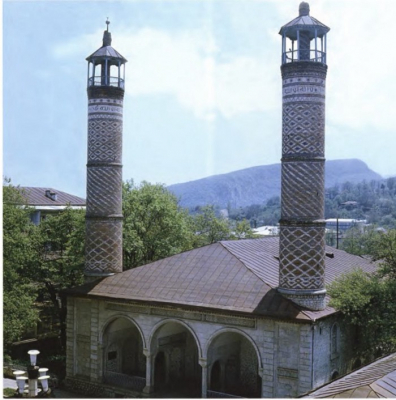Azerbaijani cultural heritage
Part 1. Islamic / Azerbaijani Mosques
While there has been an interest in and calls for preservation of Armenian heritage in and around Upper Karabakh (Dağlıq or Yuxarı Qarabağ in Azerbaijani) — a region at the center of a decades-long conflict between Armenia and Azerbaijan, the current state of Azerbaijani cultural heritage has not received similar attention by Western media. A recent petition calling to recognize all cultural heritage in the area affected by the conflict has been ignored.
Both Armenians and Azerbaijanis inhabited the Upper Karabakh / Yuxarı Qarabağ region (Azerbaijanis were concentrated in Şuşa / Shusha city and the surrounding area), while Azerbaijanis comprised a vast majority (around 780,000 people) of a much larger adjacent area in Lower Karabakh. These seven major Azerbaijani provinces were held under Armenian occupation — despite the four UN Security Council resolutions calling for immediate withdrawal of Armenian troops and the return of all displaced persons to their homes — in addition to Upper Karabakh.
A Kurdish minority — predominantly Shia Muslims — populated Laçın /Lachin and Kəlbəcər / Kalbajar districts in western parts of Azerbaijan. In addition, before the war broke out, there were around 240,000 Azerbaijanis living in Armenia concentrated in Yerevan and the Zangezur area. On the other side, some 300,000 ethnic Armenians lived in Azerbaijan before the conflict erupted in the late 1980s. Armenian Azerbaijanis were forced out of Armenia in several waves, most recently during the 1948–53 Stalin deportations and in the late 1980s. Between 1948–53, more than 100,000 Azerbaijanis were forcibly expelled from Armenia by the Stalin/Arutyunov decision (Shafiyev 2019). The decision was adopted at the request of the then Armenian communist party boss Grigory Arutyunov who advocated the resettlement of diaspora Armenians to Armenia SSR (Resolution No. 754).
At the turn of the 20th century, Yerevan (then called Erivan, or İrəvan in Azerbaijani) was home to a significant Azerbaijani community. There was an Azerbaijani theater called Yerevan Azerbaijan Drama Theater / İrəvan Dövlət Azərbaycan Dram Teatrı [1880–1988] which flourished under the leadership of Yunis Nuri. The theater was founded in 1880 in Yerevan with a play “Khan of Irevan at Novruz holiday”. The palace of Panah Khan Makinsky in Yerevan (see image) was used to stage first performances (Alibeyli 2012). From 1988, this theater continued to operate in exile.

The palace of Panah Khan Makinsky in Yerevan used for staging first performances of Yerevan Azerbaijan Drama Theater.
Another wave of forced migration of Azerbaijanis followed inter-communal clashes in 1988 that preceded the tragic events in Sumgait in 1990. There were many Azerbaijani heritage sites which were either wiped out or left neglected to decompose in Yerevan. 155 Azeri schools operated in Armenia around that time (Schulze 2017). Essentially, only one Azerbaijani site remains today — the Blue Mosque in Yerevan — which too was rebranded as a Persian mosque to erase its connection to previously significant presence of Azerbaijanis and their vibrant cultural life in Armenia.

Yunis Nuri and Azerbaijani Irevan theater in 1939 / Source: irevan.info
Karabakh’s cultural heritage therefore includes all artifacts of cultural significance including (in no particular order) Caucasian Christian (or Caucasus Albanian), Armenian, Azerbaijani, Islamic, Kurdish, Russian, Soviet, pre-Christian etc. No classification of cultural objects is perfect, and cultural categories should themselves be seen as social constructions.
Islam in Azerbaijan: Most secular Muslim country
Azerbaijan is one of the most secular countries not only among countries with nominally Muslim populations but also in the world — e.g., based on three Gallup International polls 2008, 2009 and 2015, Azerbaijan is the 13th least religious country in the world, situated between Australia and Germany.
Azerbaijani people are the least religious people in the Caucasus, far less religious and far less trusting in religious institutions than Armenians. Data from CRRC Caucasus Barometer from 2009 to 2013 shows these clearly. Some small Islamist groups have emerged since 1991 but “Some are political, but very few, if any, appear intent on employing violence to overthrow the state.” (Int. Crisis Group 2008). Much of it is a backlash against government repression.
As one academic noted, Azerbaijan is “the most secular Muslim country in the world. Among Muslim nations, Azerbaijanis are the ones who take religious ceremonies and fasting the least seriously. Men with long beards, and covered women are still unusual in Azerbaijan.”
Despite being the least religious country, Muslim artefacts are intertwined with various other cultural elements in Azerbaijan. Mosques and Islamic heritage in Azerbaijan should be understood in this context of a secular society where mosques are seen as an important part of people’s historical and cultural heritage.
Our approach:
We suggest a layered understanding of cultural artefacts evolving over long spans of time: as empires and ruling dynasties changed hands so did cultural influences. Moreover, culture is never fixed, it is fluid and evolves over time in myriad ways and tends to shape into hybrid forms blending different influences. For example, some of the mosques in Şuşa / Shusha were built in the period when the city was the center of the Karabakh khanate ruled after the region was dominated by Persianate empires which in turn themselves were ruled by Turkoman dynasties such as the Ilkhanids, Aq Koyunlu or Qajars. Persian-Turkic influences and local Caucasian traditions combined in unusual ways to produce some of the most intricate and beautiful styles and forms in Islamic art — such as the specific Qarabaghi style created by the key architect of multiple mosques Karbalayi Safikhan Garabaghi. This stylistic blend is referred to in academia as the “Azerbaijani/Islamic” style.
The same goes for Christian churches. Designating them as exclusively Armenian has its own problems given the commonplace practice of transferring local Albanian churches under the jurisdiction of Armenian Apostolic Church after the Russian takeover of the Caucasus and the imperial policy of resettling Armenians into this region. Christian churches like Dadivank / Xudavəng monastery in the Kəlbəcər / Kalbajar region are better seen as “Caucasus Christian” churches — where Albanian, Armenian and other influences mixed and produced a unique hybrid form. Ascertaining its historical ownership with greater precision is at best difficult.
Armenian mosque policies
According to official statistics, in total, 67 mosques (large and small) officially operated in the broader Karabakh region, most of them concentrated in Şuşa / Shusha, Zəngilan / Zangilan, Füzuli / Fuzuli regions. Sixty-three of them were completely destroyed in violation of Rules 38 and 40 (Attacks against/Respect for Cultural Property) of ICRC IHL Database.
Most prominent mosques are the following four:
Yukhari Govhar Agha Mosque (Azerbaijani: Yuxarı Gövhar Ağa məscidi) in Shusha
Ashaghi Govhar Agha Mosque (Azerbaijani: Aşağı Gövhər ağa məscidi) in Shusha
Saatlı Mosque in Şuşa
Ağdam Juma (Friday) Mosque
Armenian policies
Armenian policies towards Azerbaijani/ Islamic heritage sites can be grouped into two broad classes:
destruction through neglect or outright vandalism (sometimes accompanied by desecration), and
cultural erasure (more specifically, through the persianization of a mosque).
Destruction of bigger mosques was largely avoided as it would have attracted attention and criticism — remember the destruction of the Bamiyan Buddhas by the Taliban in 2001.
It seems the Armenian policy was to keep— albeit reluctantly — larger and more prominent mosques, but to delink their existence from Azerbaijani culture by persianizing them. These mosques were “allowed” to exist but as a cultural site only (no prayers allowed). On the other hand, smaller mosques and other cultural sites were simply liquidated, neglected, desecrated or left abandoned. According to preliminary assessment, 11 mosques in Shusha were destroyed in this way.
This follows a similar pattern of annihilation of Azerbaijani mosques in Erivan / Yerevan. Although the area of today’s Yerevan (then called Erivan province or khanate) hosted a large Azerbaijani population, its demographic structure changed over the span of the 19th century in favor of ethnic Armenians (Saparov 2003). According to an 1897 census, Azerbaijanis constituted around 49% of Erivan’s population at that time. Today, no Azerbaijanis live in Armenia.
Erivan mosques
Until 1915, the Yerevan province had 382 Shiite and 9 Sunni mosques, 38 Shiite mosques operated in Zangazur district (with sizeable Azerbaijani population). In the early 20th century, some of the most prominent mosques included the Blue Mosque, Haji Novruzalibay Mosque, Haji Imamverdibay Mosque, Mirzasafi bay Mosque and Haji Jafarbay Mosque in Yerevan (Nemat and Guliyeva 2012).
Zalhan məscidi
Located in downtown Yerevan (today’s Republic Square), and is one of the seven mosques that existed in Yerevan at the beginning of the 20th century. The Mosque building was demolished in 1928 to make room for Hotel Yerevan, later the exhibition hall and the House of Artists.

Zalhan məscidi
Abbas Mirza Mosque [Abbas Mirzə / Sərdər məscidi] was built in Yerevan in 1810 [during Qajar rule in Erivan Khanate]. The mosque was demolished around the 1920s, and the last ruined wall was dismantled in 2006.

Abbas Mirza Mosque
Blue Mosque
The only surviving mosque in Yerevan built in 1766 by Huseyn Ali Khan. Until its closure in 1920s, the mosque “functioned as Friday mosque for Yerevan’s Muslim (mostly Azeri-speaking) population” (Darieva 2016).
Reconstructed by the Iranian embassy in Yerevan as “exclusively Persian” mosque in 1990s and then, in 2015, leased to the same embassy to function as a cultural center.

Blue Mosque / Source: Vokrug Sveta, 2018
Destruction 1: Hiroshima-scale destruction
There is destruction, and then there is Ağdam / Aghdam, one of the most catastrophic — almost dystopian — devastation of a major town which had a population of 50,000 people. Destruction inflicted upon Aghdam is well-documented.

Central streets of Aghdam in the 1980s
In 1993, when the district of some 200,000 was occupied by the Armenian armed forces, some 140,000 ethnic Azerbaijanis were expelled and turned into displaced persons.
The town was looted. Buildings were disassembled and used as construction material by the occupying Armenian authorities. Aghdam’s Juma Mosque (see below), the only remaining cultural site, was vandalized and desecrated.
Aghdam — A postcard from HELL

Aghdam after the war
As a former U.S. diplomat explained, “When I last visited the district of Agdam, no structure was intact. Everything was taken, completely, by the Armenian side. The bricks above the surface of the ground, all the wiring, all the windows… Everything has to be rebuilt.”

Aghdam after the war
Ağdam’s Juma (Friday) Mosque was vandalized and turned into a pigsty.
It has been left to decay. To be sure, the mosque was culturally appropriated and persianized in line with Armenia’s policy to persianize other prominent mosques both in Karabakh (Shusha mosques) and Yerevan (Blue Mosque).
View before the war:

Aghdam Juma Mosque

Aghdam Juma Mosue: Damaged and vandalized

Aghdam Juma Mosque: Vandalized and desecrated/ Photo: Sputnik / A.Kudenko 2020
Evidence of persianization: the sign states “Persian Mosque”:

Source: Stepan Lohr 2011/RFE-RL
Other liberated towns were razed to the ground too. No building was left standing in the Fuzuli city (photo: REZA):

Ruins of Fuzuli city/ Photo: Reza
Destruction 2: Obliteration
The following mosques — (not a full list) — were simply obliterated.
Məmər məscidi / Mamar Mosque in Qubadlı district
Completely destroyed in 1993 after the occupation of Gubadli district by Armenian forces.

Mamar Mosque in Qubadlı district
Mosque in Dondarlı village, in Gubadlı was destroyed after Armenian occupation in 1993.

Mosque in Dondarlı village, in Gubadlı
Hacı Ələkbər məscidi / Haji Alakbar Mosque in Fuzuli city
Date of construction: 1890/ During the occupation of Fuzuli city by Armenian armed forces in 1993, Mosque was rendered useless.

Haji Alakbar Mosque in Fuzuli city
Qoçəhmədli məscidi / Kochakhmedli mosque is an 18th c. mosque in Füzuli district that was destroyed and desecrated by Armenian armed forces.

Ruins of Qoçəhmədli mosque in Fuzuli district
Famous photographer Reza Deghati witnessed several mosques desecrated. Writing about a mosque in Fuzuli’s Alkhanli village, he notes: “The scene I saw here was not any different from what I saw earlier. Apparently the Armenians have a tradition of turning mosques into barns. This shows their attitude to Muslim places of worship”. For example, he was shocked to see the Mamar mosque in Qubadlı used as a pigpen by Armenian villagers (photo: REZA):

Ruins of Mamar Mosque in Gabadli / Photo: Reza

Mamar Mosque in Gubadli used as a pigsty / Photo: Reza
A top-hill Garghabazar Mosque (Qarğabazar məscidi, also known as Qiyas əd-Din or Shah Abbas Mosque) in Füzuli district was built in 1681 next to the caravanserai and was completely destroyed after Armenian occupation of Fuzuli in 1993.

Garghabazar Mosque in Füzuli district
Köçərli məscidi / Kocharli Mosque was a 19th century mosque in Şuşa, Qarabağ. It was burned down after Armenian occupation of Shusha in May 1992.
Köçərli məscidi / Kocharli Mosque in Shusha
Mamayi Mosque in Shusha was either destroyed or repurposed after the occupation.

Mamayi Mosque in Shusha
Saatlı Mosque in Şuşa was built in 1883 by architect Karbalai Safikhan Garabaghi. After the occupation of Shusha by Armenia in 1992, a minaret was severely damaged and only ruins of Mosque remain.


Saatlı Mosque in Şuşa

Saatli Mosque — heavily damaged by Armenian occupying forces
Cultural erasure: Persianization of Qarabaghi style
Karbalayi Safikhan Garabaghi was the creator of a specific Qarabaghi style in mosque construction and architecture. He was born in a town near Tabriz in 1817 and began working in Karabakh in the 1860s (Qarabagli 2010).
The Juma Mosque in Aghdam and all mosques in Shusha were the product of his artistic genius.
Yuxarı Gövhər Ağa Məscidi — Yukhari Govhar Agha Mosque is the most monumental of all mosques in the city-castle Şuşa, considered the city’s great cathedral. It was built in place of an older mosque by Safikhan Garabakhi in 1883. The stone building of the mosque has two minarets made of bricks. The body of each minaret features several horizontal belts, and each section is decorated with a different brick pattern. Sefikhan Garabakhi used this unique technique in designing all big mosques that has come to distinguish the specific architectural style of the 19th century Karabakh mosques.
After the occupation of Shusha in 1992, this mosque was severely damaged and neglected for decades. In the 2010s, it was renovated by the Armenian separatists into a “Persian” mosque with Iranian funding, and operated as an Iranian cultural center.

Yukhari Govhar Agha Mosque in Shusha
Aşağı Gövhər Ağa məscidi
Ashaghi Govhar Agha Mosque was built in 1875 in Şuşa by the same architect.

Ashaghi Govhar Agha Mosque
This is what the mosque looked like after its destruction by the Armenian occupationist forces.


Ashaghi Govhar Agha Mosque
Conclusion
Karabakh’s multiethnic composition makes it imperative to cultivate and preserve its diverse and rich cultural and religious heritage. It’s important to recognize the diversity and multi-layered nature of cultures against the tendency to essentializing culture as something fixed and immutable. More importantly, Armenian nationalists should resist the temptation to weaponize culture to make exclusivist claims to the lands concerned. Territorial borders and sovereignty should be governed by the norms of international law.
Armenia has actively politicize material objects to substantiate its irredentist claims. However, the fact that the Dadivank / Xudavəng monastery in Kalbajar and the Ghazanchetsots Cathedral in Azeri-populated Shusha survived such a long time during the Soviet period indicates that the majority Azerbaijani population didn’t have an intention to erase those monuments in the first place.
Cultural artefacts of all ethnic, religious and secular communities whose cultural contributions form part of the rich and diverse mosaic of Azerbaijani culture must be respected as much as Armenians’ heritage.
Sources
Photos:
Most images are taken from the following sources, unless otherwise noted.
Qarabağ — irsimizin əbədi yaddaşı, 2008, https://ebooks.az/book_IP9E53Kn.html
Qarabağ: dünən, bu gün: foto şəkillərdə /Karabakh: yesterday and today: in photos, https://ebooks.az/book_WfbPYjNm.html
Назим, Мустафа. Иреванское ханство: Мечети Иревана, разрушенные армянскими вандалами, 2016, https://ebooks.az/book_sAxRHIzh.html
References:
Alibeyli, Elchin. Theatre in exile — The Irevan State Azerbaijan Dramatic Theatre, Visions, Jan-Feb, 2012. https://azvision.az/redirect.php?url=http://www.visions.az/en/news/373/f54a372d/
Azərbaycan Respublikası Məscidlərinin Ensiklopediyası, Baku, 2001, https://ebooks.az/book_jFOt7kga.html
Darieva, Tsypylma. “Prayer house or cultural centre? Restoring a mosque in post-socialist Armenia.” Central Asian Survey 35:2 (2016): 292–308. https://www.tandfonline.com/doi/abs/10.1080/02634937.2016.1140374
Məmmədov, Nahid. İşğal altındakı tarixi-dini abidələrimiz, Baku 2015, https://www.qafqazislam.com/userfiles/Abideler.pdf&ved=2ahUKEwixv_nVz9ntAhXK2aQKHfS0B58QFjAOegQIDxAB&usg=AOvVaw0_r3e9J8ieZ39A5EMqKM0p&cshid=1608366472748
Qarabağ — irsimizin əbədi yaddaşı, Baku, 2008, https://ebooks.az/book_IP9E53Kn.html
Qarabagli, Rizvan. The Domes of Karabakh, Visions, March-April 2010, https://azvision.az/redirect.php?url=http://www.visions.az/en/news/39/ef80ff99/
Nemat, Mashadikhanim and Guliyeva, Vafa. Masterpieces of Azerbaijani Architecture, IRS Heritage, 2012, https://irs-az.com/new/pdf/201212/1355229986430314358.pdf
Saparov, Arseny. “The alteration of place names and construction of national identity in Soviet Armenia.” Cahiers du monde russe 44/1 (2003): 179–198. https://doi.org/10.4000/monderusse.8604
Schulze, Ilona. “Language and identity construction: Evidence from the ethnic minorities of Armenia,” International Journal of the Sociology of Language, 248(2017), 137–157. https://doi.org/10.1515/ijsl-2017-0034
Shafiyev, Farid. “The Forced Resettlement of Azerbaijanis from Armenia, 1948–1953.” Journal of Muslim Minority Affairs 39: 2 (2019): 177–198. https://www.tandfonline.com/doi/abs/10.1080/13602004.2019.1620002
AzStudies Collective
More about:











-1734858575.jpg&h=190&w=280&zc=1&q=100)



































